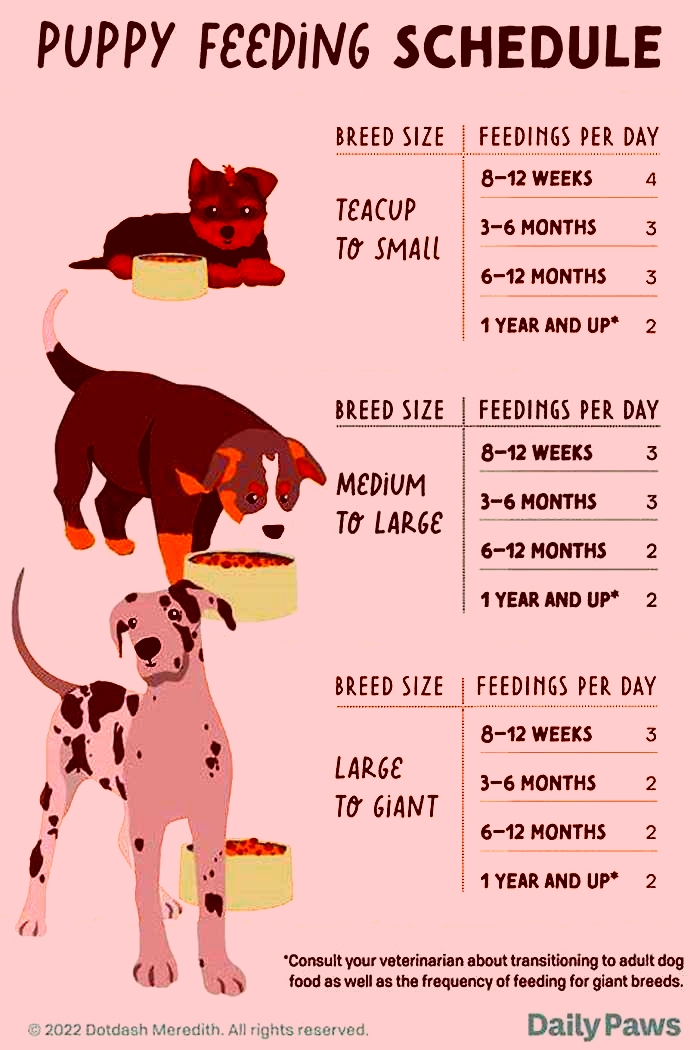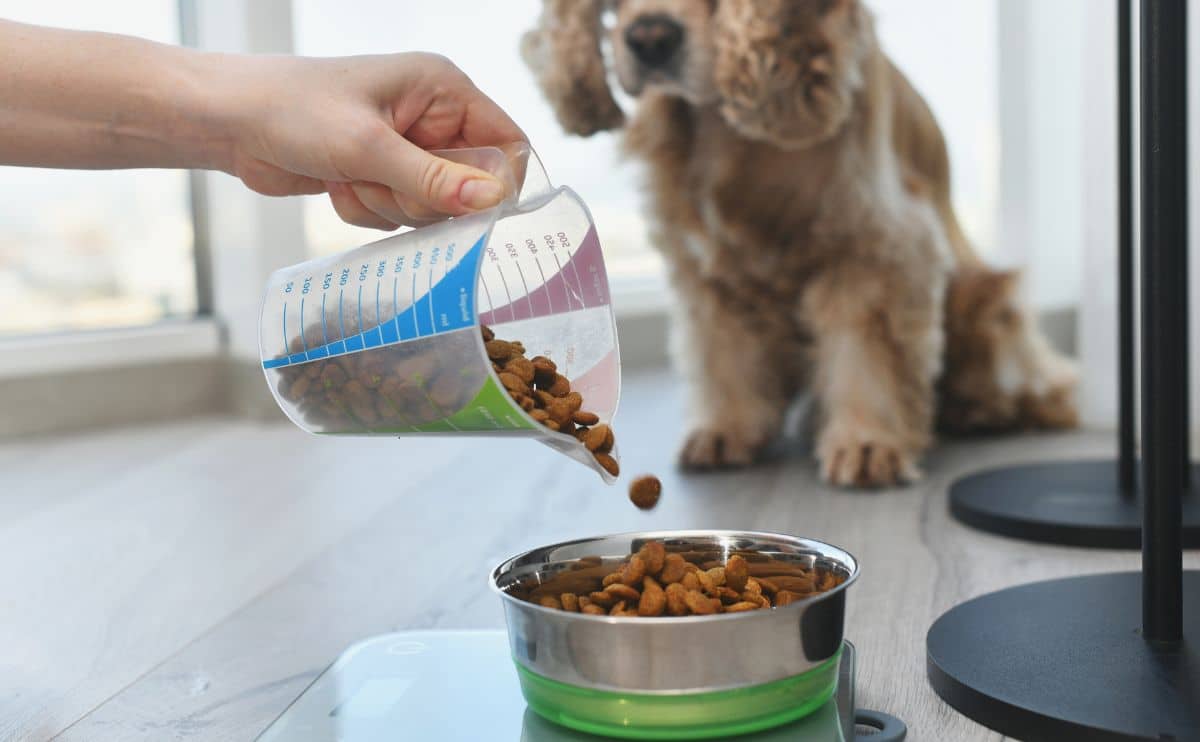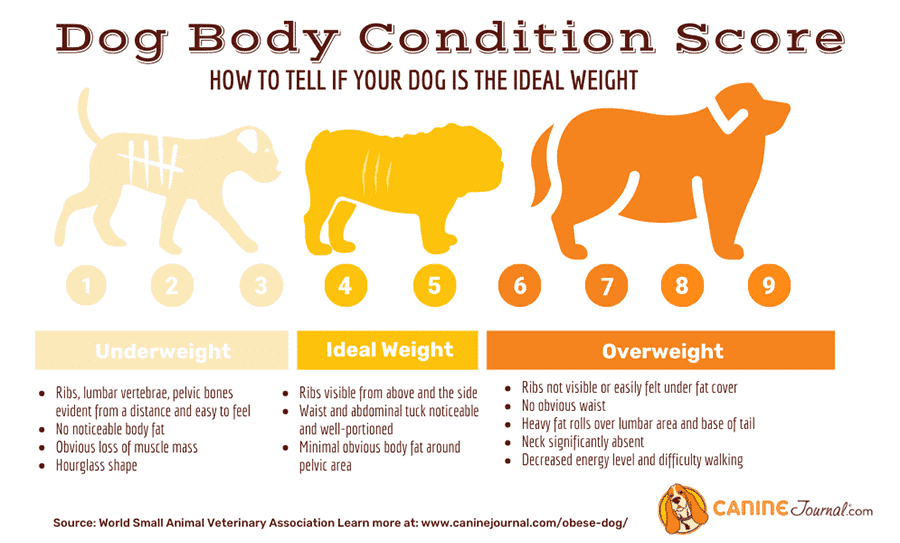How much should a dog eat a day

Are You Feeding Your Dog the Right Amount?
Why the Right Dog Food Amount Matters
If you feed your dog too little, they can suffer from nutritional deficiencies.
However, If you feed your dog too much, it will eventually result in obesity and its related health issues, like:
Giving your dog the right amount of quality dog food can help support your pets overall health and keep them feeling their best.
How to Find the Right Amount of Dog Food for Your Dog
You need to account for several factors when determining exactly how much your dog should be eating.
Consider the Important Factors
The correct meal size depends on factors like:
Type of food
Number of meals
Body weight
Metabolic rate
Amount of exercise
Look at the Feeding Guide on the Bag
To start the process, take a look at the feeding guide on your dog foods label. They are usually presented as a table that looks something like this:

Unless stated otherwise, these amounts give you the total that is recommended for your dog over a 24-hour period.
Most adult dogs should eat two meals a day, and puppies often require threeor more feedings, so youll need to divide the amount in the table by the number of meals you are offering.
Take Your Dogs Lifestyle Into Account
Combine this information with your knowledge of your dogs lifestyle to come up with the initial amount of food to offer your dog.
For example, if I had a relatively inactive 35-pound Corgi who had a tendency to gain weight, I might start with a little less food than the table recommends. On the other hand, if my dog was a 35-pound Border Collie who never sits still, I would feed a little more.
Consider Using a Calorie Calculator
Another option is to try using a calorie calculator for dogs, but keep in mind that while these often spit out a precise number, your dogs actual needs may be as much as 25% more or less.
Determine Your Dogs Body Condition Score
Whichever method you pick, youll have to use a scale orbody condition scoring systemto fine-tune the amount of food you offer.
Your veterinarian can help you decipher your dogs body condition score (BCS) and determine an appropriate calorie amount.
In general, dogs who are at a healthy weight:
Have an hourglass figure when you look down on them from above. The abdomen should be narrower than the chest and hips.
Are tucked up when you look at them from the side. This means that their chest is closer to the ground than their belly when standing.
Have ribs that are not readily visible but are easily felt with only light pressure.
Keep a Record of Your Dogs Weight Change
Check your dogs weight every 2-4 weeks and keep a diary of your results. If your dog is inappropriately gaining or losing weight, adjust your portion sizes appropriately. Make sure to discuss these changes with your veterinarian so they can ensure that there are no underlying conditions.
Reassess the Portion Size if You Switch Foods
Every time you change dog food formulas, you will have to go through this entire process again, because the number of calories in the food will be different.
Always Talk With Your Veterinarian
Talk to your veterinarian if you have any questions about your dogs health or diet. They can help you determine exactly how much food to offer based on the specifics of your dogs case.
Featured Image: iStock.com/Chalabala
How Much Food To Feed My Dog & Feeding Chart By Weight

Giving your furry friend a nutritious, well-balanced diet and not overfeeding or underfeeding are among the most important things you can do for his lifelong health. Well help you determine how much food to give your dog and how many times he should eat each day, as well as any special feeding considerations you need to consider depending on your pups health needs.
Why Is Feeding My Dog The Right Amount So Important?
One of the most frequent questions we see from pup owners is, how much should my dog eat? Knowing how much to feed your dog is crucial for his health. Being overweight or underweight can lead to serious health problems. And this can occur in smaller dogs who are just a few pounds under or over their ideal weight.
Underfed dogs can develop such conditions as chronic lethargy, dehydration, a weakened immune system, severe nutritional deficiencies that affect organ function, and cognitive problems. More common, however, is what experts say has become an epidemic of obesity in pets.
The Association for Pet Obesity Prevention (APOP) reports that over 55% of dogs in the U.S. are overweight or obese.Being overweight can shorten your dogs life and increases the risk of diabetes, heart disease, cancer, liver or kidney problems, and arthritis.
How Much Should I Feed My Dog?
Unfortunately, theres no straightforward answer to this question. Several important factors affect how much food you should be giving your pup:
- Your dogs life stage (puppy, adult, or senior)
- Type and brand of food
- Your dogs weight
- Activity level
- Your dogs body condition
- Number of meals per day
As you can imagine, it takes a bit of legwork to determine the ideal amount of food your furry friend should consume. Your best resource for nutritional guidance is your dogs regular veterinarian. But you can also follow the steps below to determine how much you should feed your pup.
Dog Feeding Chart By Weight
The best place to start is to follow your dog foods label, which can quickly answer the question, how many cups of food should I feed my dog? These feeding charts vary by type of food, brand, and caloric content of each formula. And be aware that all have their limitations.* Most also give you the daily amount to feed your pup, so youll need to divide that total by the number of meals you give your dog each day. Heres an example of a typical adult dry dog food feeding chart.
| Adult Dog Size | Dry Food Per Day |
|---|---|
| 3-5 lbs | 1/2 to 3/4 cups |
| 5-10 lbs | 3/4 to 1-1/4 cups |
| 10-20 lbs | 1-1/4 to 1-3/4 cups |
| 20-30 lbs | 1-1/3 to 2-1/3 cups |
| 30-40 lbs | 2-1/3 to 3 cups |
| 40-60 lbs | 3 to 4 cups |
| 60-80 lbs | 4 to 5 cups |
| 80-100 lbs | 5 to 5-3/4 cups |
| 100-125 lbs | 5-3/4 to 7 cups |
| 125-150 lbs | 7 to 8 cups |
| 150-175 lbs | 8 to 9 cups |
*Feeding charts are generalized and geared toward dogs who are at a healthy weight with an average activity level. They also dont take into account any special health concerns your canine companion may have. But there are ways you can further nail down how much to feed your dog after starting with your pups food feeding chart.
Factor In Your Dogs Activity Level
Take the information from your furry friends dog food feeding chart and then consider his overall activity level and daily exercise. This can help you determine whether you should feed him on the lower or upper range of the labels recommended daily amount.
For example, if you have a couch-potato Basset Hound, you likely want to give him a bit less food than the feeding chart recommends. Alternatively, if you have an Australian Shepherd whos a constant ball of energy, youll probably want to feed a little more than the suggested range.
Determine Your Dogs Body Condition Score
Evaluating your dogs current body condition can help tell you if hes too thin, at a healthy weight, or overweight.Then, you can tweak his daily caloric intake (if needed) to help him gain or lose weight. Once your dog has reached his ideal weight, youll need to adjust his portions. If your dog isnt currently at a healthy weight, its best to consult your vet for the most appropriate feeding plan for your canine companion and to check him out for any possible underlying health conditions.
To determine your pups body condition score (BCS), examine his ribs, abdomen, and waistline by sight and touch. If your dogs score is a 4-5, then weigh him to know his ideal weight. If he falls between a 1-3, he likely needs to gain weight, and a 6-9 means he needs to shed some pounds.

Use A Calorie Calculator
An alternative method is to use an online calorie calculator that will factor in your dogs BCS, but these still have some limitations in terms of factoring in your pups activity level and daily exercise.
Dont Forget To Factor In Dog Treats
When determining how much your dog should eat each day, its crucial to factor in the caloric content of any treats, table scraps, or supplements you give him. (FYI, experts advise against feeding your pup table scraps for many reasons.) Some dog treats and health supplements have more calories than you might think, and if you give these to your furry friend regularly, it could lead to weight gain.
If your pup is a huge treat fan, look for healthy, low-calorie options. We recommend Fruitables Skinny Minis or Wellness CORE Jerky Bites. And if your vet has determined you should give your dog a daily joint supplement or another type of supplement for his health needs, youll need to subtract the calories of that from his daily food intake.
How Much To Feed Puppies & Seniors
Senior dogs typically require fewer calories than adults because their activity and metabolism have slowed down. Once your canine buddy has reached his senior years, most vets advise putting him on a dog food formulated specifically for elder dogs. Typically, these formulas have fewer calories and less fat content, which are appropriate for their slowing activity and metabolism.
Puppies are in an entirely different category when it comes to feeding needs. Its extremely important to follow feeding guidelines for your puppy because these requirements change every few weeks or months as he grows quickly. See our in-depth puppy feeding guide for a detailed puppy feeding chart by weight/age and much more.
How Often Should I Feed My Dog?
Ideally, most adult dogs should eat at least two meals per day, approximately 12 hours apart. Likewise, three meals spread out equally during the day is another excellent option. If your dogs breed is at a higher risk for canine bloat, its recommended to feed smaller, more frequent meals.
When you feed your pup is entirely up to your daily schedule, but its important to set up regular feeding times and stick with them. Dogs thrive on routine, so theyll be most content with meals served around the same time each day.
Your Best Dog Food Options
Are you considering switching to a different dog food? If you havent settled on a new diet, we encourage you to see our various dog food reviews. Weve researched hundreds of types, brands, and formulas to help you narrow down your options. See ourrecommended foodsfor any age, diet type, and health concern, thebest dog food delivery servicesfor puppies and adult dogs, and our top picks for fresh dog food.
Tagged With:Dog Food Calculator
The Dog Food Calculator can help you estimate the proper serving size for your pet. Its based upon a study published by the respected Waltham Centre for Pet Nutrition in Leicestershire, England. 1
To use the calculator, youll need to know your dogs ideal weight. This is what you believe your pet should weigh.
Youll also need to know the number of calories in the specific dog food youre feeding him.
The calculators formula2 uses a dogs metabolic weight to suggest an approximate serving size.
Dog Food Calculator Guidelines
The Dog Food Calculator was designed for adult dogs only not for puppies.
And it should never be used for pregnant or lactating females.
Small breeds are considered adults at about 9 to 12 months of age. And medium breeds at about 12 to 14 months.3
However, large and giant breeds shouldnt be fed as adults until they reach around 1 to 2 years depending upon the breed.4
What's the best dog food?
Overweight Dogs
If you believe your dog might be overweight, be sure to choose the Overweight option for Your dogs activity level.
Otherwise, the recommended serving size will likely be too high.
And for help, be sure to visit our Best Dog Foods for Weight Loss article.
Senior Dogs
Older dogs have significantly lower energy needs than younger ones.So, its easy for them to put on extra weight.
In general, small to medium dogs are considered seniors at about seven years of age. However, larger breeds reach senior status much sooner some as early as five.5
Converting From Calories to Serving Size
Once youve entered your dogs ideal weight and activity level, youll know the number of calories per day.
However, to convert calories into something you can use, youll need to enter the number of calories in your dogs food.
The number of calories in a given amount of dog food is known as its metabolizable energy (ME, for short). Its usually reported somewhere on a dog food package like this
- Calories per cup (kcal/cup)
- Calories per kilogram (kcal/kilogram)
By the way, the calculator assumes youre feeding your dog just once a day.
If you prefer to feed your dog twice a day, be sure to divide your result in half so that both meals add up to the full daily calories suggested.
The Bottom Line
Since every dog is unique, its impossible to predict the serving size thats perfect for each pet.
So, start with the packages feeding instructions or the amount suggested by our calculator.
And be sure to weigh your dog every few weeks.
Then, simply adjust that suggested serving size up or down to reach and maintain your pets ideal weight.
